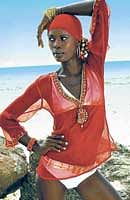Africa at a glamorous juncture

In the wealthy neighbourhoods of Lagos, Nigeria; Nairobi, Kenya; Luanda, Angola; and the like, ladies of leisure, successful businesswomen and middle-income housewives make up an attractive demographic that, in the past, relied on international fashion magazines for style and beauty information.
But in the last few years, while Conde Nast, Hearst and Hachette Filipacchi were expanding throughout Asia, Eastern Europe and the Middle East, a handful of African publishers were busy staking claims to this publishing territory. A result has been a series of new glossies, like Arise, HauTe, Helm and True Love, that put an African spin on fashion.
“Honestly, upwardly mobile African readers are crying out for this magazine,” said Helen Jennings, editor of Arise, a monthly style publication started late last year by the Nigerian media tycoon Nduka Obaigbena, who also owns the country’s leading newspaper, ThisDay. “Because the local magazines aren’t as high-end or progressive, and no other international titles speak directly to an African readership, Arise has really caused a stir.”
Among magazines in English-speaking Africa, Arise alone packages both pan-African and global content, producing a blend that Jennings calls ‘afropolitan’. With a reported circulation of about 60,000 and averaging about 140 pages a month, the magazine is distributed in seven other African countries and around Europe and North America. In its no-expense-spared fashion shoots, clothes by African designers are paired with global brands like Yves Saint Laurent, Loewe and Ralph Lauren using popular black international models like Oluchi Onweagba and Rahma Mohamed.
Interviews with prominent black celebrities, like the singer-songwriters Akon and VV Brown, appeal to global advertisers. Tommy Hilfiger, Juicy Couture, Graff, L’Oreal and Lacoste are all represented in the magazine’s pages. And their prestige has helped pull in ads from fashion brands based in Nigeria, Ghana and Tanzania. Several of the African magazines have opened editorial headquarters in Europe or the United States to be closer to brand samples, top models, talent agencies, photo facilities and printing companies of a higher standard than most in Africa. Arise, for example, operates out of London, and Helm, an Ethiopian quarterly, is based in Washington. Although these locations help editors produce quality content, they also drive up prices, as the finished magazines must be shipped to African newsstands.
While a financier’s deep pockets can be all that is needed to start a magazine, several factors, including market size, literacy and wealth, are needed to sustain it. Most of sub-Saharan Africa’s statistics in these categories are poor, but they sometimes belie the real potential. Literacy rates are low in many sub-Saharan countries, but parts of the population with enough disposable income to afford magazines have much better literacy rates than the national averages. Nigeria’s rate is higher than 70 percent, and Kenya’s is above 80 percent; both have become regional centers for publishing.
Africa’s pockets of wealth also are often buried in gloomy macrostatistics. “In most sub-Saharan African countries, only 5 percent to 10 percent of the population is at the top of the income pyramid,” said Sakina Balde, an analyst for Africa and the Middle East at the market research firm Euromonitor International. “While this might seem insignificant, in highly populated countries like Nigeria, for example, it represents a large number of individuals.”
According to 2008 data, 1,10,200 households in Nigeria had an annual disposable income of more than $75,000. And last year the country’s 150 million residents spent $750.4 million on newspapers, magazines, books and stationery. “Nigeria and Angola are both oil producers, and many people made a fortune in the oil industry or through various businesses,” Balde said. “High- and middle-income earners in these countries have an insatiable desire for luxury products, and this is not waning with the economic slowdown.”
The continent’s wealth, though disproportionately concentrated, already is being spent by affluent Africans who shop in cities like London, Paris, Johannesburg and Dubai for luxury goods. Several luxury retailers and stores in London, for example, already count Nigerians among their top five spenders.
Apart from South Africa, where editions of Elle, Marie Claire, Glamour and Cosmopolitan have been around for the better part of a decade, major international publishers continue to shy away from Africa. Still, certain African countries are starting to become interesting for international publishers. While Asia and Eastern Europe remain the most popular destination for the expansion of fashion magazine brands, several industry executives agreed that the current global downturn and the changing media landscape worldwide might make a wide open market like sub-Saharan Africa attractive after all.
Deccan Herald is on WhatsApp Channels| Join now for Breaking News & Editor's Picks